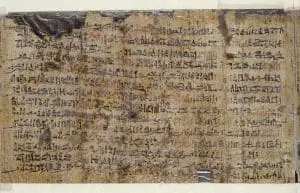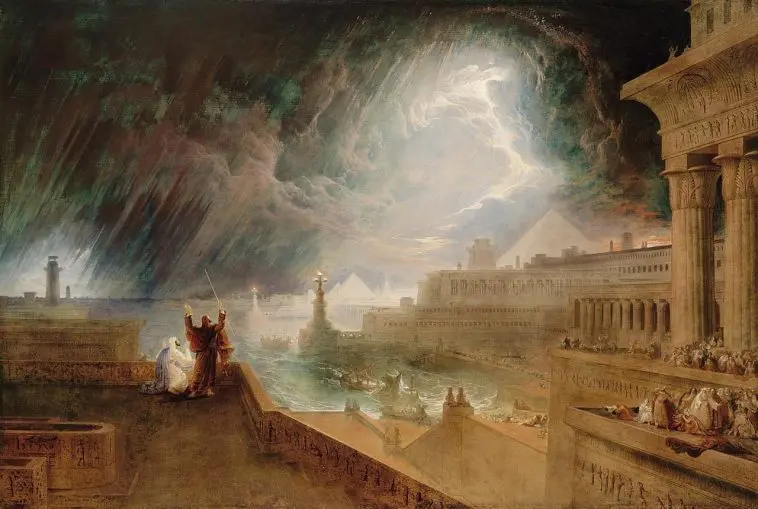In Part 4 of this series, we considered the correlation of the El Amarna letters with the events recorded in the books of Joshua and Judges in the Bible. We now turn our attention to the Papyrus of Ipuwer, a remarkable Egyptian papyrus that may very well be an Egyptian account of the biblical plagues on Egypt in the book of Exodus. (See also Part 1, — Part 2, — Part 3, and Part 4.
God’s Sovereignty Over Nature
When I was about 22, one of my friends at church was a guy named Dave. Dave had a lawn and landscaping business, and, due to conflicting obligations, he asked me if I could spend about five hours the following Sunday cutting the grassy field of one of his customers. I agreed, and after church that next week, Dave introduced me to the customer and left.
The weather was not looking cooperative. Ominous black clouds had moved in and filled the entire sky, and it looked like it would storm any moment. The owner gave me the key to his riding mower in the shed but suggested that it might not be a good idea to try to mow the field that day considering the weather. Scattered drops of rain were already starting to come down. I told him that if it got too bad I would return the mower to the shed and call it a day.
I looked at the sky as I hopped on the mower and it did not look good at all. It was completely cloudy and the clouds were very dark. The scattered raindrops coming down seemed to forebode a rather quick end to my venture. So I prayed, asking the Lord to hold off the storm long enough to do the job I had agreed to do.
I drove the mower over to the field and began to mow. Within a few minutes, I noticed the sun beginning to shine on me. I looked up at the sky and saw a nearly perfect, small circle of clear sky directly above me with the sun shining in it, surrounded by black clouds everywhere else! I just knew immediately that God had answered my prayer.
For the next five hours I mowed the field on the riding mower. The circular opening in the clouds above me remained directly over my head and did not move. The sun shone so brightly on me that I got a good, strong sunburn. As I was finishing up, I noticed that the clouds were closing in again: no more sunny opening—just ominous rain clouds. As I put the mower in the shed, it started to rain lightly again. By the time I took the key back to the owner in his house, there was a heavy downpour. I ran back to my car in the torrential rain and it rained heavily for the entire 35-minute drive back to my home.
When I arrived, my mother asked me how in the world I got sunburned with heavy rain all over the region that day. I turned on the news and according to the weather report, there had been nothing but heavy rain across an entire third of the US for about the last six hours.
I relate this story to emphasize to the reader that the God of the Bible is not some mere myth of primitive desert-dwelling nomads of the past, but the very real God of the present who can manifest His glory and His power when He so wills. I got a taste of the living God and His glory that day as He manifested His power over the natural world.
Because of experiences like this, I have no problem believing the incidents of the book of Exodus exactly as they are related.
The Papyrus of Ipuwer (or “The Admonitions of a Sage”)
In the Leiden Museum, (more precisely the Rijksmuseum van Oudheden), in the Netherlands, there is an Egyptian papyrus in their collection labeled as “Leiden 344.” The papyrus, written in Hieratic Egyptian script (i.e., a phonetic script), is generally believed to have been written (most likely copied from another older papyrus) somewhere between 1290 BC – 1150 BC. By examining the words, phrases, grammar, and style of the language, some scholars believe the original was written ca 1450 BC – 1440 BC. This is significant because the Exodus of the Israelites from Egypt occurred in 1446 BC. (See 1 Kings 6:1 and Judges 11:26.)

I first learned about this papyrus when reading the book, Moses and Pharaoh, which was published in 1985 by Christian commentator, Gary North, but I did not appreciate the significance of the document at that time. The papyrus was written by an Egyptian scribe by the name of Ipuwer (EE-poo-wehr). It describes and laments in poetic form a time of great calamities that came upon Egypt. Ipuwer describes these events as an eyewitness. What is fascinating about the papyrus is its similarity to the list of plagues on Egypt mentioned in the book of Exodus.
Is the Papyrus of Ipuwer, in fact, an Egyptian account of those plagues?
Comparison of Exodus with Ipuwer
Consider this comparison of Exodus to the Papyrus of Ipuwer. (I am following the format of Michael Lane in his Evidence4Faith video.)
Ipuwer: First, and most significantly, Ipuwer states, “There is blood everywhere. The river is blood.” – i.e., the Nile River
Exodus 7:20–21: “And Moses and Aaron did so, as the Lord commanded; and he lifted up the rod, and smote the waters that were in the river, in the sight of Pharaoh, and in the sight of his servants; and all the waters that were in the river were turned to blood. And the fish that was in the river died; and the river stank, and the Egyptians could not drink of the water of the river; and there was blood throughout all the land of Egypt.”
Ipuwer: “One thirsts for water.”
Exodus 7:24: “And all the Egyptians digged round about the river for water to drink; for they could not drink of the water of the river. 25 And seven days were fulfilled, after that the Lord had smitten the river.”
Ipuwer: “Lo, trees are felled, branches stripped.”
Exodus 9:24–25: “So there was hail, and fire mingled with the hail, very grievous, such as there was none like it in all the land of Egypt since it became a nation. And the hail smote throughout all the land of Egypt all that was in the field, both man and beast; and the hail smote every herb of the field, and brake every tree of the field.”
Ipuwer: “Lo, grain is lacking.”
Exodus 9:31–32: “And the flax and the barley was smitten: for the barley was in the ear, and the flax was bolled. But the wheat and the rie were not smitten: for they were not grown up.”
Ipuwer: “Birds find neither fruit nor herbs.”
Exodus 10:14–15: “And the locust went up over all the land of Egypt, and rested in all the coasts of Egypt: very grievous were they; before them there were no such locusts as they, neither after them shall be such. For they covered the face of the whole earth, so that the land was darkened; and they did eat every herb of the land, and all the fruit of the trees which the hail had left: and there remained not any green thing in the trees, or in the herbs of the field, through all the land of Egypt.
Ipuwer: “Groaning is throughout all the land, mingled with laments.”
Exodus 12:29–30: “And it came to pass, that at midnight the Lord smote all the firstborn in the land of Egypt, from the firstborn of Pharaoh that sat on his throne unto the firstborn of the captive that was in the dungeon; and all the firstborn of cattle. And Pharaoh rose up in the night, he, and all his servants, and all the Egyptians; and there was a great cry in Egypt; for there was not a house where there was not one dead.”
Ipuwer: “Lo, many dead are buried in the river, the stream is the grave, the tomb became a stream, and he who puts his brother in the ground is everywhere.”
Numbers 33:4: “For the Egyptians buried all their firstborn, which the Lord had smitten among them: upon their gods also the Lord executed judgments.”
Ipuwer: “All is ruin.”
Exodus 10:7: “And Pharaoh’s servants said unto him, How long shall this man be a snare unto us? let the men go, that they may serve the Lord their God: knowest thou not yet that Egypt is destroyed?”
Ipuwer: “The land is without light.”
Exodus 10:22–23: “And Moses stretched forth his hand toward heaven; and there was a thick darkness in all the land of Egypt three days: They saw not one another, neither rose any from his place for three days: but all the children of Israel had light in their dwellings.”
Ipuwer: “Gold and lapis lazuli, silver and malachite, carnelian and bronze…are fastened on the neck of female slaves.”
Exodus 12:35–36: “And the children of Israel did according to the word of Moses; and they borrowed of the Egyptians jewels of silver, and jewels of gold, and raiment: And the Lord gave the people favour in the sight of the Egyptians, so that they lent unto them such things as they required. And they spoiled the Egyptians.”
Ipuwer: “Indeed, all animals, their hearts weep; cattle moan because of the state of the land….”
Exodus 9:3, 6: “Behold, the hand of the Lord is upon thy cattle which is in the field, upon the horses, upon the asses, upon the camels, upon the oxen, and upon the sheep: there shall be a very grievous murrain… and all the cattle of Egypt died.”
Ipuwer: [Behold, he who did not know] his god now offers to him with incense of another ….”
This segment sounds very much like the record of the book of Exodus which tells us of Moses learning the name of the God of Abraham, Isaac, and Jacob and revealing His name to the clan of Jacob who were mired down in slavery and, to a large extent, corrupted by the religion and gods of Egypt (Exodus 3). I believe what we have in the Ipuwer papyrus is an Egyptian eyewitness account of the ten biblical plagues on Egypt. There are just too many parallels to not be referring to the same events.
A Secular Assessment of the Papyrus
Maarten Raven, who is a curator of the Leiden Museum where the papyrus is housed, claimed, in an interview with filmmaker Timothy Mahoney, that there is no connection between the Ipuwer Papyrus and the biblical account of the plagues upon Egypt. (See excerpt here.)
Raven, who is an Egyptologist, says the document is a “beautiful literary document.” And that it came from somebody who was “obviously in a position to address his Majesty the King.”
According to Raven, it describes, or purports to provide, a “vivid report of what happens to Egypt when the central power falls away.” Raven contends that the papyrus “pretends to be such an account, but in fact it isn’t.”
But how can Raven prove his assertion? Raven disputes what the document itself is claiming to be. Where is Raven’s evidence for that claim? It appears to be no more than a preference of his own liking with no written records or artefactual evidence to back up his claim.
Raven says Ipuwer “received his inspiration from other propagandistic literature.” Raven is, ironically, alluding to the Bible in this remark, a significant claim, indeed, considering the standard claim of the secularists is that the Bible did not come to be until many centuries afterward!
The usual claim of the Naturalists in academia is that even the Israelites themselves did not come into being until centuries later. If Raven is correct in this assertion, then we have the biblical account first, sometime around 1446 BC, and then Ipuwer using the biblical account as inspiration for his own poem maybe sometime in the 1290 BC – 1150 BC time frame.
What About the Chronology?
Archaeologist, Titus Kennedy, in an online interview, mentions an Egyptian bard named Ipuwer who lived somewhere around the Hatshepsut, Thutmose III period (18th Dynasty). There is a tomb inscription with the name of Ipuwer on it.
This connects the Papyrus of Ipuwer very closely to the biblical timeframe of the Exodus. This is momentous! We have not only thematic elements that sound like the book of Exodus, but written at a time close to the biblical chronology of the Exodus. This stretches the credulity of the claim that there is no connection between the Papyrus of Ipuwer and the biblical Exodus to the breaking point.
How much more evidence does a reasonable person need?
This is historical, extra-biblical evidence of the plagues related in the book of Exodus from an Egyptian perspective. There is no rational denial of this.
One may counter that this is not absolute proof, nor am I claiming it is. I am claiming this is evidence strongly weighted in favor that there are actual historical events behind both documents. The plagues happened, as both the book of Exodus and the Papyrus of Ipuwer proclaim. Skeptics can claim that those plagues were nothing but natural occurrences, but I do not think it is credible to claim that these plagues never happened at all.
The Same Ipuwer?
Is the Egyptian songwriter of the Hatshepsut/Thutmose III era the same Ipuwer who wrote the Papyrus? I do not know. I would say this is a strong possibility. Or maybe the writer of the Papyrus is the son of the bard Ipuwer named on the Egyptian tomb?
In Part 6A of this series, we will consider the discovery of the altar of Joshua by Israeli archaeologist, Adam Zertal.
Additional resources regarding the Papyrus of Ipuwer:
- Michael Lane’s presentation about the Ipuwer Papyrus.
- Full text of the Ipuwer Papyrus.
- Archaeologist, Titus Kennedy, “Archaeology and the Exodus“
- Titus Kennedy on additional references to Ipuwer.
- Titus Kennedy video discussing the dating of the Papyrus.
- Armstrong Institute of Archaeology article.
- Anne Habermehl covers these points in her paper for the International Conference on Creation.
- See also Gary North’s discussion of the Papyrus in his book, “Moses and Pharaoh,” pg 308-312.







